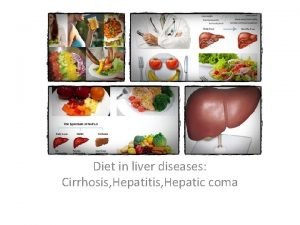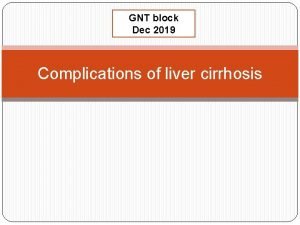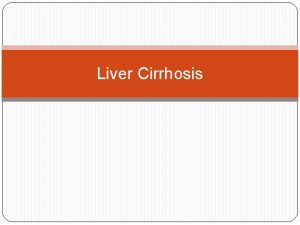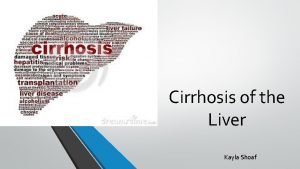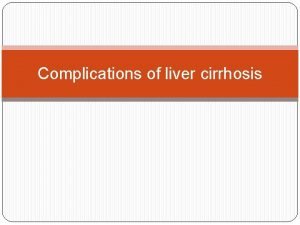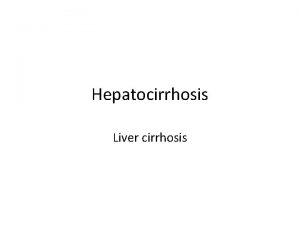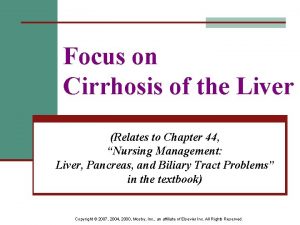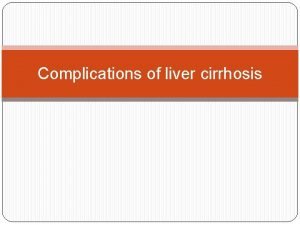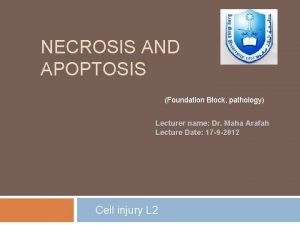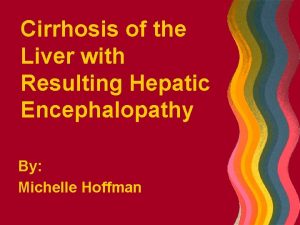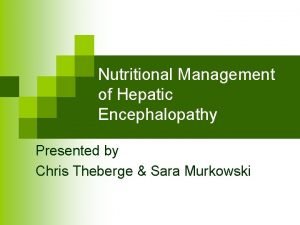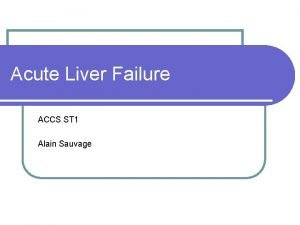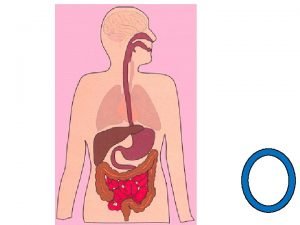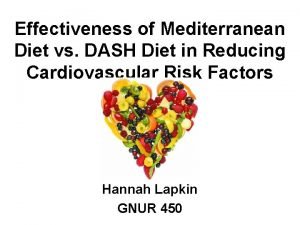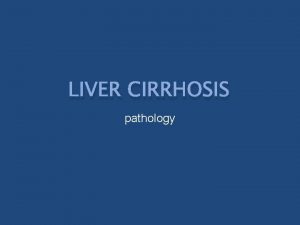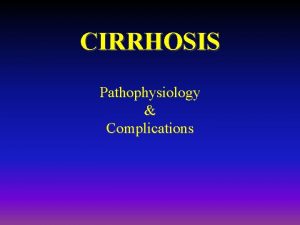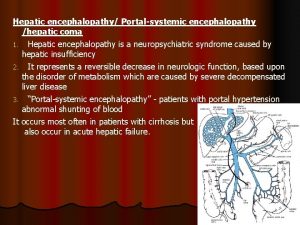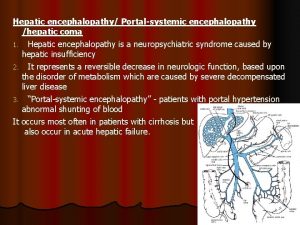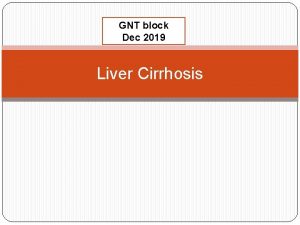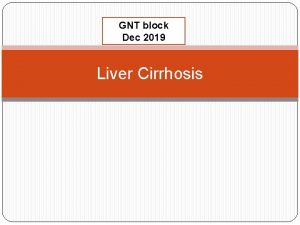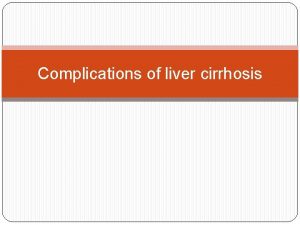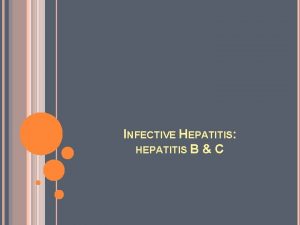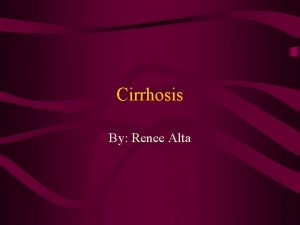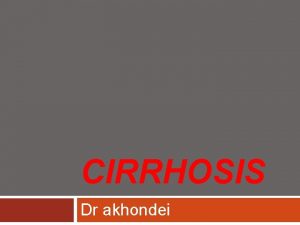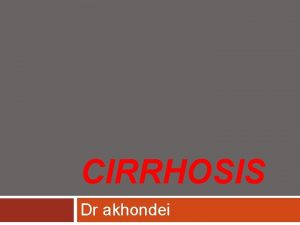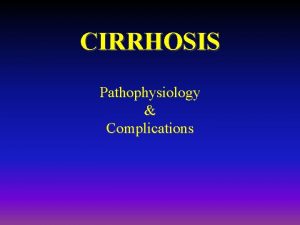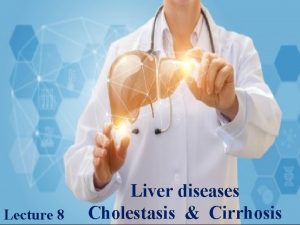Diet in liver diseases Cirrhosis Hepatitis Hepatic coma

















- Slides: 17

Diet in liver diseases: Cirrhosis, Hepatitis, Hepatic coma

Liver • The liver is the most metabolically active organ in the body. • It is located in the upper right hand side of the abdomen, mostly behind the rib cage. • The liver of an adult normally weighs close to three pounds and has many functions. • It plays a central role in processing, storing and redistributing the nutrients provided by the foods we eat. • More than 500 functions have been identified and no other organ is concerned with so many functions

Functions of liver The primary functions of the liver are: • Bile production and excretion. • Excretion of bilirubin, cholesterol, hormones, and drugs. • Metabolism of fats, proteins, and carbohydrates. • Enzyme activation. • Storage of glycogen, vitamins, and minerals. • Synthesis of plasma proteins, such as albumin, and clotting factors. •

Meaning of liver disease • Types of liver diseases: Cirrhosis, Hepatitis, Hepatic coma • Since liver is responsible for many critical functions within the body and should it become diseased or injured, the loss of those functions can cause significant damage to the body. Liver disease is also referred to as hepatic disease. • Liver disease is a broad term that covers all the potential problems that cause the liver to fail to perform its designated functions. Usually, more than 75% or three quarters of liver tissue needs to be affected before a decrease in function occurs. •

How liver can be damaged? The liver can be damaged in a variety of ways. • Cells can become inflamed, for example, hepatitis. • Bile flow can be obstructed, for example, cholestasis). • Cholesterol or triglycerides can accumulate, for example, steatosis). • Blood flow to the liver may be compromised. • Liver tissue can be damaged by chemicals and minerals, or infiltrated by abnormal cells, like cancer cells.

Cirrhosis • Cirrhosis is a late-stage of liver disease. • It is a slowly progressing disease in which healthy liver tissue is replaced with scar tissue, eventually preventing the liver from functioning properly. The scar tissue blocks the flow of blood through the liver and slows the processing of nutrients, hormones, drugs, and naturally produced toxins. It also slows the production of proteins and other substances made by the liver. • Scarring of the liver and loss of functioning liver cells cause the liver to fail. Significant amounts of liver cells need to be damaged before the hole organ fails to function


What causes cirrhosis of the liver? Hepatitis C, fatty liver, and alcohol abuse are the most common causes of cirrhosis of the liver in the U. S. , but anything that damages the liver can cause cirrhosis, including: ü Fatty liver associated with obesity and diabetes ü Chronic viral infections of the liver (hepatitis types B, C, and D; Hepatitis D is extremely rare) ü Blockage of the bile duct, which carries bile formed in the liver to the intestines, where it helps in the digestion of fats

What are the symptoms of cirrhosis of the liver? The symptoms of cirrhosis of the liver vary with the stage of the illness. In the beginning stages, there may not be any symptoms. As the disease worsens, symptoms may include: • Loss of appetite • Lack of energy (fatigue), which may be debilitating • Weight loss or sudden weight gain • Bruises • Yellowing of skin or the whites of eyes (jaundice) • Itchy skin • Fluid retention (edema) and swelling in the ankles, legs, and abdomen (often an early sign) • Blood in the stool • Fever Complications: Hepatic encephalopathy results from Increased ammonia levels due to the liver's inability to process and metabolize proteins in the diet can cause confusion, lethargy and coma

Complications: • Hepatic encephalopathy results from Increased ammonia levels due to the liver's inability to process and metabolize proteins in the diet can cause confusion, lethargy and coma • Hemorrhage • Acute renal failure • Hepatocellular carcinoma

Nutritional consideration in liver cirrhosis • Medication: The typical management of cirrhosis involves medications (eg, lactulose) that decrease the absorption of ammonia, a compound that is a main cause of hepatic encephalopathy. • Calorie: Malnutrition, a common complication in liver cirrhosis, is associated with poorer outcome. Consequently, a diet that provides 25 to 40 kcal/kg body weight a day is usually prescribed • Vegetarian diet: Dietary changes, such as the use of vegetable protein instead of animal protein, may also lower blood ammonia levels. Plant-based diets have more dietary fiber, which may reduce ammonia-related encephalopathy in two ways: first, by enhancing the use of nitrogen by colonic bacteria; and second, by facilitating nitrogen removal from the body by speeding food remnants through the intestines. Vegetable protein sources are also higher in arginine, an amino acid that decreases blood ammonia levels through increasing urea synthesis. They are also lower in methionine and tryptophan, amino acids that exacerbate encephalopathy through gut conversion to neurotoxic metabolites (mercaptans and oxyphenol, respectively).


• Branched-chain amino acids: Nutrition therapy, particularly with branched-chain amino acids, can also help support patients who are losing weight due to poor appetite and may improve survival. • Sodium restricted diet: A sodium-restricted diet is standard treatment. A 2000 mg sodium-restricted diet is effective, when combined with diuretic therapy, for controlling fluid overload in 90% of patients with cirrhosis and ascites.

• Low fat diets: Several investigations have concluded that excess dietary fat may encourage cirrhosis progression. High intakes of total fat, saturated fat, and polyunsaturated fat have been implicated.

HEPATITIS

Causes of hepatitis

 Hepatic coma diet
Hepatic coma diet Pes statement for liver cirrhosis
Pes statement for liver cirrhosis Hyperestrinism cirrhosis
Hyperestrinism cirrhosis Cirrhosis pathogenesis
Cirrhosis pathogenesis Pes statement for liver cirrhosis
Pes statement for liver cirrhosis Splenomegaly liver cirrhosis
Splenomegaly liver cirrhosis Symptoms liver cirrhosis
Symptoms liver cirrhosis Types of cirrhosis
Types of cirrhosis Complication of liver cirrhosis
Complication of liver cirrhosis Mitochondrial swelling
Mitochondrial swelling Liver defination
Liver defination What causes liver cirrhosis
What causes liver cirrhosis Stages of hepatic encephalopathy
Stages of hepatic encephalopathy Acute liver failure
Acute liver failure Hepatic lobules of liver
Hepatic lobules of liver Hepatic encephalopathy staging
Hepatic encephalopathy staging Puntos suspensivos función
Puntos suspensivos función Dash diet vs mediterranean
Dash diet vs mediterranean
